Samsung H03 Review
Samsung H03
This tiny LED projector is stuffed with features yet can be had for a bargain price.
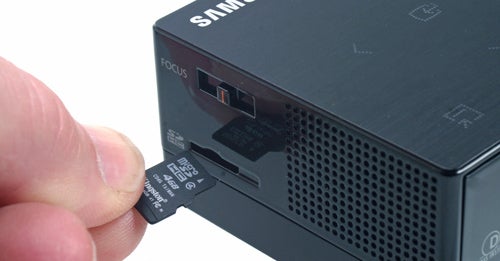
Verdict
Key Specifications
- Review Price: £203.70
Samsung is certainly no stranger to the portable projector game, having previously impressed us with the award-winning SP-P400B. But where that projector (weighing in at 1kg and with a 14 x 14cm footprint) was only portable, the new H03 is truly pocketable. In fact, it’s difficult to see how Samsung managed to squeeze all the technology, buttons and connectivity into a package weighing a mere 130g (209g with its battery attached) and with a footprint of just 7cm (under three inches) squared!
However, despite successes like the BenQ GP1, not all our experiences with pico projectors have been positive, as aptly demonstrated by Optoma’s first effort, the Pico PK101. Let’s hope then that this Samsung makes the grade.
In terms of design, features and connectivity, it’s certainly very accomplished. It’s one of the more visually attractive portable projectors available, beating even 3M’s MPro150. Samsung’s effort presents a streamlined cube with few buttons and no connections marring its sides (the former are mainly touch-sensitive while the latter are hidden behind a flap). Its top is black brushed metal and overall build quality is flawless.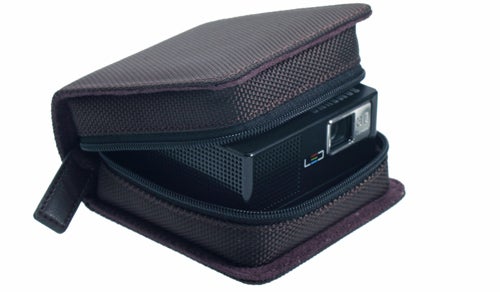
The provided carrying case is also on another level. It’s a thickly-padded, semi-hard affair providing decent protection. The exterior is textured brown nylon with a soft velvet lining inside preventing scratches or marks, and a black zip with a brown leatherette pull-tag. There’s no provision for carrying any of the adapters or the power supply, but then in many scenarios you won’t need them anyway thanks to the projector’s built-in battery and storage.
Technically the H03 is equally impressive. It uses Texas Instruments’ highly-regarded DLP technology to provide a 1,000:1 native contrast ratio and sports a widescreen resolution of 854 x 480 (very similar to that found on today’s high-end smartphones, and indeed Samsung has already matched the two with the i8520 Beam). This means no or reduced black bars on the majority of films, though it’s arguably not the ideal aspect ratio for data presentation.
Though on larger projectors LED bulbs are still a rarity, typically found on £10,000-plus models such as the Vivitek H9080FD and SIM2 Grand Cinema MICO 50, on pico projectors these are a necessity rather than a luxury. This is for the simple reason that ‘regular’ bulbs would produce far too much heat and need to be far too large to produce an equivalent brightness output to this Samsung’s incredible (for its size) 30 lumens. Its lamp is rated at 30,000 hours, so you shouldn’t need to worry about replacements in the projector’s viable lifetime. 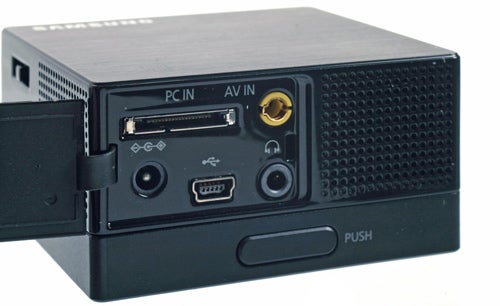
Connectivity is extensive, especially considering the H03’s size. Behind its little rear panel you’ll find a 3.5mm jack that caters for composite video and stereo audio using the supplied adapter and a proprietary analogue connector that can be used either with the supplied VGA adapter or an optional component one. There’s also a 3.5mm headphone jack and a mini-USB output, which can be used with the supplied female USB adapter cable to plug in any USB storage up to 16GB.
Not that that’s the only way to get files onto this pico projector, as there’s a micro-SD card slot just below the focus slider on the right side that will take cards up to 16GB (the same limitation as on USB sticks), and of course you can store data on the H03’s relatively generous 1GB local memory. 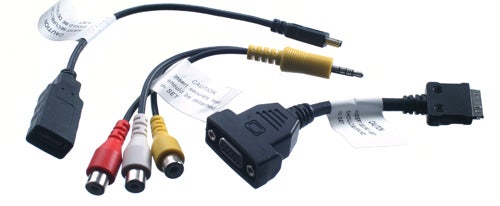
The focus slider is small and slightly fiddly but not to the point of being frustrating, so long as you have a modicum of patience. A small push-button below the connectivity cover releases the battery.
Power and navigation controls are found at the projector’s top, etched subtly into the brushed metal surface. After pressing the power ‘button’ for a few seconds, all controls become backlit in white, making them easy to see whether in darkness or bright daylight. There’s a beeping sound to indicate a ‘press’, which can be set to loud, quiet or (thankfully) turned off altogether. 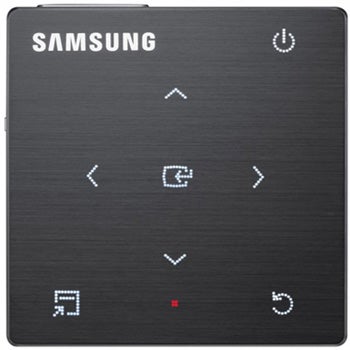
However, we still prefer physical buttons that offer tactile feedback and can be used without needing to look at the unit, especially as on several occasions, we accidentally ‘pressed’ the touch controls while attempting to adjust focus. Frankly, it’s a clear case of style over substance. It’s also a shame that Samsung doesn’t include a remote as some of its competitors do, but then the H03 is considerably cheaper than its closest rivals.
The H03’s power brick is almost as large as the projector itself. However, once its detachable 10.95Wh battery is fully charged – indicated by a small but clearly visible LED indicator on the machine’s top – you can do away with cables completely. It is good for up to one and a half hours of video playback with the lamp set to full brightness, and up to two hours in Eco mode, which is perfectly usable (depending on throw distance) in a darkened room. One thing to keep in mind is that, once its battery runs low, the projector will refuse to recognise external USB storage, so it’s safer to put your files on a micro-SD card than a memory stick. 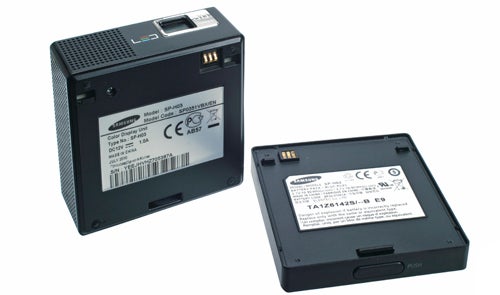
If, on the other hand, you’re running the projector off the mains, you can simply detach the battery and you’ll be left with a device that’s only 2.5cm (1inch) high. However, you do lose the metal tripod mount found in the battery’s base, which will often be useful in avoiding distortion as the H03 doesn’t offer keystone adjustment. The battery can also be somewhat fiddly to re-attach. At full brightness the H03 consistently consumed less than 12W, while in Eco mode this went down to 8W.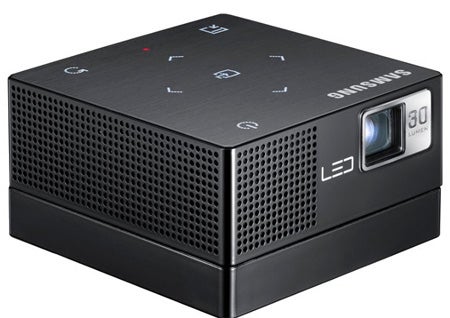
Samsung’s intuitive OSD is attractive and gives easy access to all the functions you need. The top icon lets you switch between video inputs, while the icons below that provide access to files stored locally or on attached storage. For each type of storage (Internal, SD or USB) you can access files by type, with a choice between Documents, Videos, Photos, Music or Settings. Incidentally, the Settings menu is the same no matter which storage device you access it through, as this controls the options of the projector.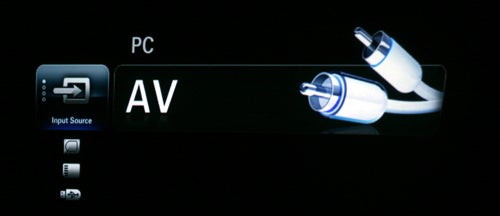
One of the H03’s standout features is its ability to display Microsoft Office documents without the need for a laptop. In our testing we found it displayed every single document type we threw at it, from the latest Word .docx file standard to Excel spreadsheets, though sometimes they did take very long to load. Once up and running, it did an impressive job despite inevitably awkward navigation (zooming in and out, for example, was hardly intuitive, nor was changing pages within a document). Like every other pico projector the Samsung still won’t cope well with a brightly lit room, so ideally you’ll want to dim the lights and draw the curtains. 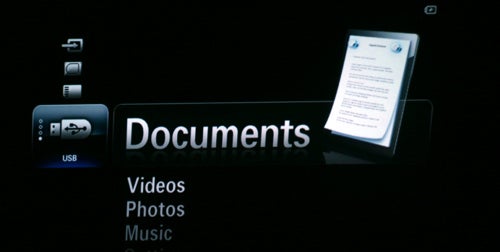
Surprisingly, despite its business and presentation ambitions, entertainment was where the projector really shone (in both senses of the word). Quite aside from its impressive image quality, there’s the underpublicized revelation that the H03 will play back non-intensive (i.e. as long as bit-rate is kept below a certain level) 720p video, including AVI, WMV, MP4, MOV, MKV and even RMVB! For pictures it can handle JPEG and GIF while on the audio front you can play back MP3 and WAV. That’s some darn impressive media player functionality considering it’s not even highlighted on Samsung’s website.
Obviously you can’t expect large projector quality or HD levels of sharpness from the H03, but nevertheless the image it produced was dynamic, engaging and detailed up to around 60 inches – and frankly had no right coming out of something this small and affordable. 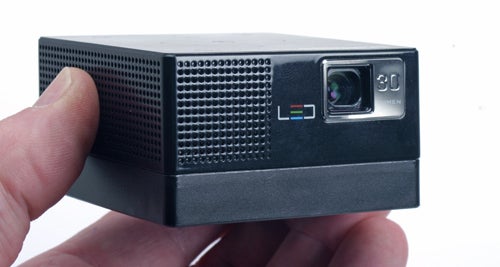
In a darkened room, colours were vibrant but not too oversaturated, with fairly realistic skin tones and natural greens. A slight lack of sharpness due to the low resolution and relatively unsophisticated lens might even be considered to add to the cinematic feel. What’s especially impressive is that, with lamp brightness set to normal and when projecting on a decent surface, blacks are black and dark detailing is surprisingly good, revealing detail that’s lost on many TN-based LCD screens (like those you get on most laptops and cheap monitors). Just keep in mind that due to the H03’s lack of optical zoom, you’ll need a long throw distance to get a big picture.
Audio from the pico projector’s tiny mono speaker was never going to be great but it’s certainly adequate for presentations and – in a pinch – just about bearable for films. Of course you can always hook up external speakers using the headphone jack, and though in one instance it transmitted noise to a set of headphones we tested with, in general there were no problems.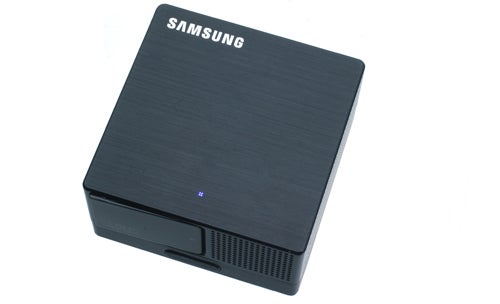
The projector itself produces an audible hum as soon as you turn it on, which is slightly reduced in Eco mode. It’s definitely noticeable in a quiet environment but is never intrusive enough to be annoying. After running at full brightness for a while, the H03 becomes warm but never hot to the touch.
One of the best things about this impressive little projector is its price, which at a mere £204 is considerably lower than its nearest rival, the Optoma PK301 (though this does offer HDMI out and a remote control). If you don’t mind something considerably larger, the portable BenQ GP1 is also an option, but despite its superior specifications we feel the H03 is not only considerably cheaper but also more attractive and versatile. As long as you have access to a darkened room and a large, flat surface, you’re essentially walking around with a 60in (albeit not HD ready) TV in your pocket.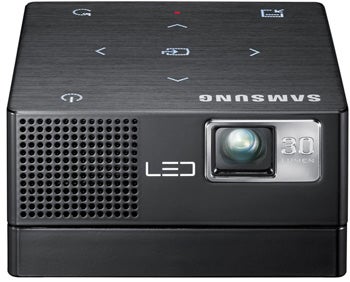
Verdict
Samsung’s tiny H03 pico projector offers appealing looks and great presentation combined with decent battery life, above-average performance and more features than you can shake a long stick at (including native document viewing and video playback). Its only real flaws are awkward controls and a lack of any digital video input, but its bargain price makes that easy to forgive.
Trusted Score
Score in detail
-
Value 9
-
Features 8
-
Image Quality 8
-
Design 9

